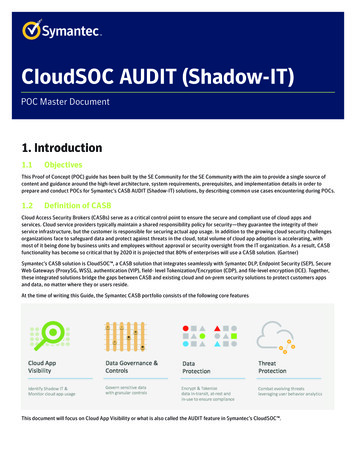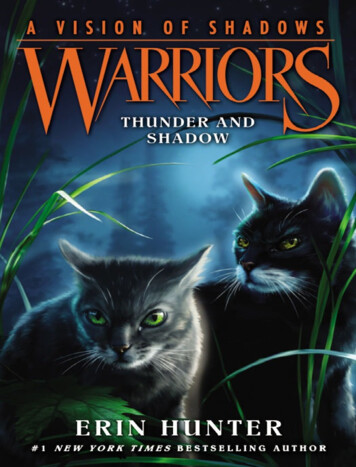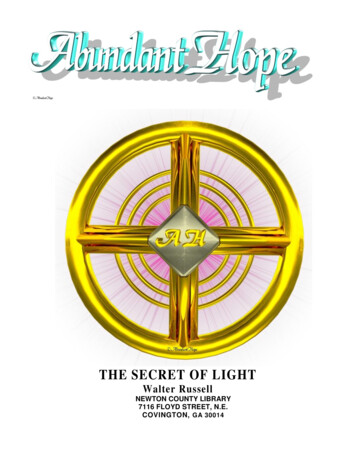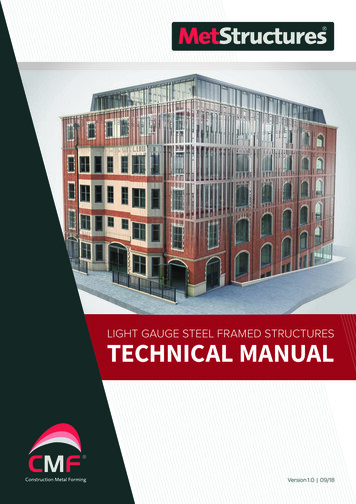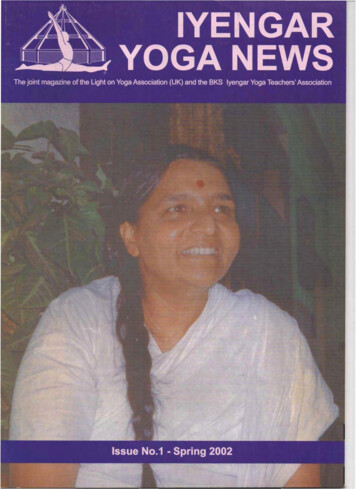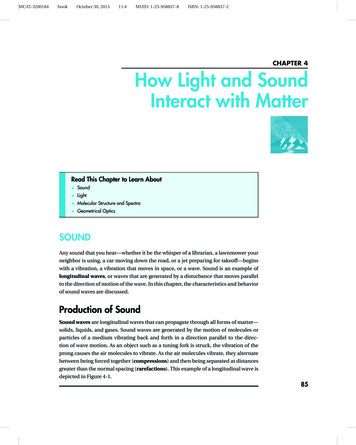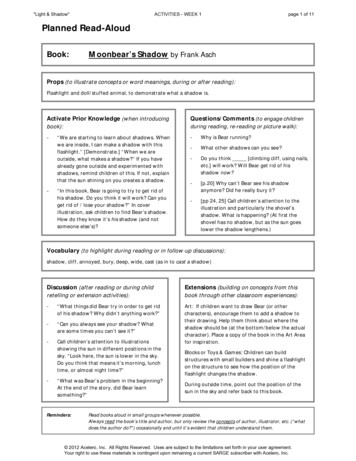
Transcription
"Light & Shadow"ACTIVITIES - WEEK 1page 1 of 11Planned Read-AloudBook:Moonbear’s Shadow by Frank AschProps (to illustrate concepts or word meanings, during or after reading):Flashlight and doll/stuffed animal, to demonstrate what a shadow is.Activate Prior Knowledge (when introducingbook):--“We are starting to learn about shadows. Whenwe are inside, I can make a shadow with thisflashlight.” [Demonstrate.] “When we areoutside, what makes a shadow?” If you havealready gone outside and experimented withshadows, remind children of this. If not, explainthat the sun shining on you creates a shadow.“In this book, Bear is going to try to get rid ofhis shadow. Do you think it will work? Can youget rid of / lose your shadow?” In coverillustration, ask children to find Bear’s shadow.How do they know it’s his shadow (and notsomeone else’s)?Questions/Comments (to engage childrenduring reading, re-reading or picture walk):-Why is Bear running?-What other shadows can you see?-Do you think [climbing cliff, using nails,etc.] will work? Will Bear get rid of hisshadow now?-[p.20] Why can’t Bear see his shadowanymore? Did he really bury it?-[pp 24, 25] Call children’s attention to theillustration and particularly the shovel’sshadow. What is happening? (At first theshovel has no shadow, but as the sun goeslower the shadow lengthens.)Vocabulary (to highlight during reading or in follow-up discussions):shadow, cliff, annoyed, bury, deep, wide, cast (as in to cast a shadow)Discussion (after reading or during childExtensions (building on concepts from thisbook through other classroom experiences):-“What things did Bear try in order to get ridof his shadow? Why didn’t anything work?”-“Can you always see your shadow? Whatare some times you can’t see it?”-Call children’s attention to illustrationsshowing the sun in different positions in thesky. “Look here, the sun is lower in the sky.Do you think that means it’s morning, lunchtime, or almost night time?”Art: If children want to draw Bear (or othercharacters), encourage them to add a shadow totheir drawing. Help them think about where theshadow should be (at the bottom/below the actualcharacter). Place a copy of the book in the Art Areafor inspiration.retelling or extension activities):-“What was Bear’s problem in the beginning?At the end of the story, did Bear learnsomething?”Reminders:Blocks or Toys & Games: Children can buildstructures with small builders and shine a flashlighton the structure to see how the position of theflashlight changes the shadow.During outside time, point out the position of thesun in the sky and refer back to this book.Read books aloud in small groups whenever possible.Always read the book’s title and author, but only review the concepts of author, illustrator, etc. (“whatdoes the author do?”) occasionally and until it’s evident that children understand them. 2012 Acelero, Inc. All Rights Reserved. Uses are subject to the limitations set forth in your user agreement.Your right to use these materials is contingent upon remaining a current SARGE subscriber with Acelero, Inc.
"Light & Shadow"ACTIVITIES - WEEK 1page 2 of 11Planned Read-AloudBook:Guess Whose Shadow by Stephen R. SwinburneNOTES:This simple nonfiction book has interesting photos that will help illustrate the concept of shadows,while engaging children in guessing what cast each shadow. Because this is such a visual book, it isideal to read in small groups (or give different children turns to come up, look closely and guess).Props (to illustrate concepts or word meanings, during or after reading):Flashlight; several objects with different shapes (e.g. stuffed animal, pencil, etc.)Activate Prior Knowledge (when introducingbook):Questions/Comments (to engage childrenduring reading, re-reading or picture walk):-“Yesterday we read about Moonbear’s shadow.What else has a shadow? What other shadowshave we seen? Where can you see shadows?”-(page 1) “What is the boy doing? Where isthe shadow?” Let a child use words todescribe where the shadow is.-Read the Forward to the children. When readingabout how a shadow is made, demonstrate witha flashlight and an object.-(page 2) Have a child or two come up andpoint to a shadow they found on the page.--Show children the shadows of several differentobjects. “How is the bear’s shadow differentfrom the pencil’s (etc.)?” Guide children tounderstand that shadows have similar shapes tothe actual object. Explain that in this book wewill see photographs of many different shadowsand we can guess whose shadows they are!(page 5) This page shows three picturesillustrating positional words. Ask children inwhich picture the shadow is in front,behind, and next to.-Throughout the book, stop on pageschildren seem interested in and ask themabout the shadows: where, what, etc.Vocabulary (to highlight during reading or in follow-up discussions):in front, behind, below, next to, appear, cast, shadedDiscussion (after reading or during childExtensions (building on concepts from this bookretelling or extension activities):through other classroom experiences):-“Can you see a shadow right now fromwhere you are sitting? What/where is it?”Play “guess whose shadow” with the pictures in theback of the book (during Circle Time, transitions, etc).-“In the book we saw pictures of bigshadows and little shadows. Can you thinkof anything that would cast a little shadow?A big shadow?”When outside, encourage children to look around forshadows.Use positional vocabulary and illustrate for children(especially Dual Language Learners) as needed. Forexample, during transitions say, “If you are sitting infront of the book case, stand up”; “If you are standingbehind Jonathan, go choose a book.” Or placechildren on the rug by giving them directions: “Janet,sit behind Lucas.” “Marcus, sit in front of Makai.” 2012 Acelero, Inc. All Rights Reserved. Uses are subject to the limitations set forth in your user agreement.Your right to use these materials is contingent upon remaining a current SARGE subscriber with Acelero, Inc.
"Light & Shadow"ACTIVITIES - WEEK 1page 3 of 11Planned Read-AloudBook: Corduroy by Don FreemanNOTES:This classic children’s story book includes an illustration of a flashlight, creating a natural connection with theLight & Shadow theme. If you have a bilingual staff member, consider doing a re-reading in Spanish (keeping inmind that books should be read in only one language at a time – no switching back and forth!).Activate Prior Knowledge (whenintroducing book):--Call children’s attention to the coverillustration. “These are called overalls – that’sa type of clothing that’s like pants, but withstraps over your shoulders. Do you seeanything missing from Corduroy’s overalls?”Explain that in this book a bear is going to golooking for a missing button.“Corduroy is a toy bear who lives in a bigstore, called a department store, where theysell toys but also furniture, like beds andchairs.” Invite children to talk about theirown experiences shopping or make theconnection to any local stores children mayknow (Target, Walmart, etc.).Questions/Comments (to engage childrenduring reading, re-reading or picture walk):-(p.7) Lisa wants to buy Corduroy and take himhome. What do you think she likes about him?What might she want to do with him at home?-(p.13) “Look at Corduroy riding up the .” Pauseand see if children know the word escalator. Askif any children have ridden an escalator (or referto local stores, malls, train stations etc. theymight know).-(p.17) What is Corduroy doing to the mattress?What do you think will happen next?-(p.20) – What does the night watchman have inhis hand? (A flashlight!) Why do you think he’scarrying a flashlight?Vocabulary (to highlight during reading or in follow-up discussions):Customers, department store, overalls, search, escalator, mattress, yank, night watchman, flashlight, piggy bankDiscussion (after reading or during childExtensions (building on concepts from this bookthrough other classroom experiences):At the end, Corduroy gets a home and he also getsa friend. What do you think he and Lisa will donext, now that they are friends? What would youdo with Corduroy if he were your friend?Toys & Games Area – add a variety of buttons, withcontainers to sort them, thread to string them on,and/or tweezers to pick them up with.retelling or extension activities):Point out where Lisa comes back to the store tobuy Corduroy with money from her piggy bank (p.27). Explain that a “piggy bank” is a containerwhere people save coins. Can children rememberanother book where people saved coins to buysomething they wanted? Discuss similarities to AChair for My Mother.Reminders:Talk to children about the animals, dolls, or otherspecial “lovies” they may have at home (just likeCorduroy is Lisa’s new cuddly friend). Revisit KnuffleBunny or recall conversations you had on this topicearlier in the year.Also see “Corduroy Storytelling Extension” SmallGroup Activity.Read books aloud in small groups whenever possible.Review this guide in advance, but don’t refer to it during the read-aloud. (If you need a reminder aboutcomments/questions to use in different parts of the book, try using sticky notes.) 2012 Acelero, Inc. All Rights Reserved. Uses are subject to the limitations set forth in your user agreement.Your right to use these materials is contingent upon remaining a current SARGE subscriber with Acelero, Inc.
"Light & Shadow"ACTIVITIES - WEEK 1page 4 of 11Small-Group ActivityACTIVITY:Hand ShadowsOVERVIEW:Children will have the opportunity to make shadows, using only a light and their hands. This activitykicks off the “Light and Shadow” theme by getting children interested and more familiar with theconcept; it is also an opportunity to build language and support Dual Language Learners.OBJECTIVES: School Readiness Goal (5) Understanding School Readiness Goal (6) Speaking School Readiness Goal (7) English GOLD 8a (comprehends) GOLD 9a (vocabulary) GOLD 37 (understands English) & 38 (speaks English) WSS II.B.2 (vocabulary/language) ELS 7 (speaking)MATERIALS:PROCEDURE: Light source(s): flashlights and/or a stationary source, such as a desk lamp or spotlight.Guess Whose Shadow by Stephen R. Swinburne Recommended: prepare by learning to make at least one type of shadow-animal with your hands. Seeexamples at OTE: Conduct this small-group activity near a light-colored wall or other surface (to better see theshadows). For example, you could gather in the Block Area and drape a sheet over one of the shelves.Beginning:1.“This week we are going to learn a lot about shadows. You will have a chance to make a shadowyourself! First I am going to show you how to make a shadow using only two things – this light andmy hand.” Ask children for their ideas about how to do this and expand on short answers.2.Shine the light on your (open) hand and ask children to find the shadow. Change the position ofyour hand and point out how the shadow changes. Encourage children to tell you what they see,and describe what you are doing in simple, clear language.3.Show children how you can use your hand to make a shadow that looks like something else! Youcould make bunny ears (or any other type of Shadow Hand Puppet)—then make the shadow “hop”and ask children to guess what it is.Individualization: (To support School Readiness Goal (7) – English) Move around and speak briefly with individual children to ensure they understand the activity.Give simple, clear instructions while demonstrating the motions yourself: “Here is the shadow ofmy hand / Mira, es la sombra de mi mano.” When children speak in one- or two-word phrases, repeat what they say and extend: “Hand? Elenathinks I will use my hand. But what I should do with my hand? Elena, can you show me?¿Muéstrame por favor?” If needed to help children understand, translate key vocabulary into children’s home language.(Animals from “shadow hand puppets” resource: dog/perro, goat/ cabra, goose/ganso , wolf/lobo,elephant/elefante, hare/conejo, bear/oso, ox/ buey, butterfly/mariposa, donkey/burro or asno.) Becareful not to overuse this strategy, as “simultaneous translation” can confuse children; however,using the word once in Spanish, early in the activity, can help children understand the English wordas you reinforce it throughout the activity.Middle:4.Tell children that they will all have a chance to make hand shadows! Suggest that while waiting fortheir turn, they think about what kind of shadow they will make. “How will you hold your hand?”5.Help children take turns using the lamp or flashlights (if you have multiple, children can hold 2012 Acelero, Inc. All Rights Reserved. Uses are subject to the limitations set forth in your user agreement.Your right to use these materials is contingent upon remaining a current SARGE subscriber with Acelero, Inc.
"Light & Shadow"ACTIVITIES - WEEK 1page 5 of 11Small Group Activity (cont’d)flashlight for each other) to make hand shadows. Encourage them to experiment with differentshapes, movement, using both hands, etc. If needed, give children suggestions: “Tiana, do youthink we could make a shadow that looks like your T? How would we do it?” “Minh’s shadow looksflat and thin, like a worm. I wonder if you can make it crawl across the ground.”6.Use language modeling and feedback throughout this activity. Comment on the shadows childrenare making (“Joe, when you bend your fingers like that, your shadow looks like a claw”) andencourage children to describe the shadows (either what they made or what another child’sshadow looks like). Repeat what children say and extend it, particularly for Dual LanguageLearners who may need support to use new vocabulary.7.Have the book Guess Whose Shadow available and allow children to peruse it for ideas or whilethey are waiting their turn.End:YOU MIGHTDOCUMENT:8.Give children a 2-minute warning, e.g.: “There is time for one more friend to make a shadow.”9.Show children where the materials will be available during choice time (e.g., Block Area, Discovery,etc.) and encourage them to continue making shadows!What type of language do children use? Do they describe the process, explain what they are going todo, and/or use varied vocabulary to name the shadows being created? For Dual Language Learners,notice whether they understand and respond to your English comments or whether they need thephrases in their home language. Do they use any English words to name or describe their shadows? 2012 Acelero, Inc. All Rights Reserved. Uses are subject to the limitations set forth in your user agreement.Your right to use these materials is contingent upon remaining a current SARGE subscriber with Acelero, Inc.
"Light & Shadow"ACTIVITIES - WEEK 1page 6 of 11Small-Group ActivityACTIVITY:Shape Blocks and PatternsOVERVIEW:Children will use “parquetry blocks” to explore different shapes and create patterns. This hands-onexperience will allow children to better understand the different properties of shapes (sides, corners,angles, length, etc.) and to create patterns using a different type of material.OBJECTIVES: School Readiness Goal (13) Shapes School Readiness Goal (14) Patterns GOLD 21b (understands shapes) GOLD 23 (patterns) WSS III.C.2 (patterns) WSS III.D.1 (recognize/describe shapes) ELS 2 (algebraic thinking) ELS 3 (identifying/using shapes)MATERIALS:-PROCEDURE:Parquetry blocks (also known as pattern blocks; these are flat plastic shapes in a variety of colors, for ex.green hexagons, orange triangles, yellow diamonds, etc.)Baskets for each child containing their materialsFor extension: Pattern cards – index cards or strips of paper showing sample patterns, such as square-circlesquare-circle or circle-circle-triangle, circle-circle-triangle.Beginning:1.Tell the children you have some different shapes for them to use today. Show them a shape andask what they notice about it. Name the shape and talk about its properties: number of sides,length of sides, number of corners, the color. Do this with a few of the other shapes.2.Tell children they will have their own shapes to use. “I wonder how you will use them?”Middle:3.Allow children to explore independently with their shapes. Talk with children about what they aredoing with their shapes, and model different possibilities. Refer children’s creations or findings toother children, as appropriate. Individualization (to support School Readiness Goal (13) – Shapes)i. Tier 1—For children who do not identify shapes, help them focus on simple ones, such ascircles, squares or triangles. You might provide them with a more limited set of materials(for example, just two shape choices instead of six) and help them to sort by shape. Pointout characteristics of the shapes: “How do we know this is a square? Let’s count thesides .I noticed that all of the sides are the same length. Do you see any other squares?”ii. Tier 2—For children who can identify some shapes, support them in recognizing andnaming others (diamonds, rectangles, etc.) Encourage these children to manipulate theshapes in various ways: for example, they might turn or flip shapes to confirm whethertwo pieces are the same, or combine two shapes to make another. “I see you put twoparallelograms together and you made a new shape! This shape is called a hexagon. Lookwhat happens when I put two triangles together can you help me?”iii. Tier 3—For children who identify multiple shapes and manipulate them easily, encouragethem to compare the specific attributes between various shapes, noting similarities anddifferences. “That’s right, the trapezoid and the rectangle each have four sides. But whatis different about them? Individualization for Dual Language Learners – Model language by narrating children’s actions asthey work with the materials (parallel talk). Keep your language relatively simple andstraightforward, and repeat key words or phrases: “I see you have three green triangles anothergreen triangle! They are in a line. You have four green triangles in a row.” 2012 Acelero, Inc. All Rights Reserved. Uses are subject to the limitations set forth in your user agreement.Your right to use these materials is contingent upon remaining a current SARGE subscriber with Acelero, Inc.
"Light & Shadow"ACTIVITIES - WEEK 1page 7 of 11Small Group Activity (cont’d)4.Extension: Encourage children to create patterns with the shapes. You can build off what they arealready doing (“Look, you put triangle, square, triangle, square. That’s a pattern! What shouldcome next?”) or provide pattern cards to use as a model, inviting children to try copying a patternor suggesting they create their own.End:YOU MIGHTDOCUMENT:5.Give children a 5-minute warning for clean up.6.Have children put away the materials by shape. “Let’s put all of the rhombuses away first. Nowlet’s put all of the squares away.” You can even clean up in a “pattern” – alternating shapes oralternating children! (“Lily puts one away then Deondre. Lily, Deondre, Lily, Deondre.”)Do children use the appropriate shape names? Do they notice features of the shapes, or combine twoidentical shapes to make a new one? Do children create patterns (either independently or by copyingor extending a model)? 2012 Acelero, Inc. All Rights Reserved. Uses are subject to the limitations set forth in your user agreement.Your right to use these materials is contingent upon remaining a current SARGE subscriber with Acelero, Inc.
"Light & Shadow"ACTIVITIES - WEEK 1page 8 of 11Small-Group ActivityACTIVITY:Shadows & SilhouettesOVERVIEW:Children will learn more about light by shining a light source on different classroom items andseeing the shadows they produce. At the same time, they will each have their silhouette drawn– and will be able to match the silhouettes to the children who cast the shadows! This is a greatopportunity to engage a parent volunteer(s) to help trace/ cut out the silhouettes.OBJECTIVES: School Readiness Goal (1) Social Skills School Readiness Goal (6) Speaking School Readiness Goal (17) Inquiry GOLD 3a (balances needs), 3b (solves social probs) GOLD 10a (conversations) GOLD 24 (scientific inquiry) ELS 4 (observation/reporting) ELS 5 (prosocial behavior, social prob-solving) ELS 7 (speaking)WSS I.D.1 (interacts with children)WSS I.E.1 (resolves conflicts)WSS II.B.2 (vocabulary/language)WSS IV.A.1 (asks questions/uses senses)MATERIALS:-PROCEDURE:Note: hold this small-group activity near a wall or flat surface, to make it easier to draw thechildren’s silhouettes.Desk lamp or large flashlight for silhouettesLarge sheet of light-colored paper for each student (taped to wall)Pencil or thin sharpie to trace each silhouetteFlashlights for children’s useItems from around the classroom to shine light on (dinosaurs, counters, plastic people from blockarea, solid/transparent materials, etc.)Beginning:1.Tell children you are going to shine a flashlight and you want to see what they notice aboutthe light. Encourage children to describe the direction of the light and that it is shining in astraight line.2.Tell children that light travels in a straight line. Put something in the light’s path (a block orlarge dinosaur from the block area) and ask children what happened. When the light isblocked by something and it can’t get through, it casts a shadow.3.Tell children that they are going to make shadows with some items that you have collected.While they are making shadows, you are going to work with each of them to use theirshadows to make a silhouette. A silhouette is an outline of something or somebody and it isusually very dark.Middle:4.Provide children with a basket of objects from around the classroom. Be sure to go oversafety guidelines for using a flashlight. Tell them that they can create their own shadowswith these objects like you did with the block and the dinosaur.5.As children explore with the flashlights, comment on what they are doing and model newpossibilities. Encourage sharing and turn-taking with the flashlights, and facilitate asneeded to prevent or solve any social conflicts that may arise. Individualization (to support School Readiness Goal (1) – Social Skills):i.Tier 1 – Support children’s development of self regulation skills. Engage them in 2012 Acelero, Inc. All Rights Reserved. Uses are subject to the limitations set forth in your user agreement.Your right to use these materials is contingent upon remaining a current SARGE subscriber with Acelero, Inc.
"Light & Shadow"ACTIVITIES - WEEK 1page 9 of 11Small Group Activity (cont’d)discussions about their plans and feelings. “I can tell by the way you are standing thatyou are angry that Theo took that dinosaur from you. Let’s take a couple of deepbreaths and see if we can talk to him about that.”ii.Tier 2 – Support children with emerging self-regulation by helping them recognizeother people’s feelings and make suggestions to prevent conflicts. Point out, “Aliselooks sad. Alise has been waiting patiently for a long time for her turn to hold theflashlight. Can you give her a turn now? Why don’t you hold the paper over here whileshe shines the light?”iii. Tier 3 – Children who take turns with materials and solve social problems that arise canbe role models for others. Give children problems to solve and acknowledge the ideasthey have for solving the problems and working together. This will encourage others tocopy the desired behaviors. “How will you keep the light up behind the doggy and tracethe silhouette on paper at the same time? Great idea Jordan. Thanks for offering tohold the light so that Marisol can trace the silhouette of that puppet.”6.While children are working, call them with rhymes (“If your name rhymes with Bonika,come sit in the special silhouette chair”). Teacher or parent volunteer will position child inthe chair with light source in front of them and white paper taped to wall behind them.Turn child so the profile of their face is displayed on the wall with the paper.7.Quickly trace the child’s shadow, talking about what you are doing as you go along. Whencomplete, move the light and show child his/her silhouette. “Does it look like you? How canyou tell?” Individualization (to support Dual Language Learners): Use parallel talk to describewhat you are doing as you trace the child’s shadow. Keep your language simple, clear,and directly related to what is happening. Repeat and reinforce key vocabulary – whichcould include body parts (nose, hair, eyes, mouth, head), shadow, etc.End:8.Give children 5 minute warning to clean up their materials and flashlights.9.Ask children to tell you one thing they noticed about their shadow making.10. FOLLOW UP: To better view the silhouettes, cut out each profile and/or trace them with aheavier dark marker. (This is also a great task for a parent volunteer!) Display silhouettesat children’s eye level, or look at them during a Circle Time, and invite children to guesswhich belongs to whom. How do they know? Encourage them to describe thecharacteristics that helped them determine which silhouette belongs to which child.WHAT TODOCUMENT:Do children explore and experiment with the flashlights and shadows? Do they engage inconversations (with adults or other children) about their silhouettes or the shadows they arecreating? Note how children work together and whether they are able to share materials, taketurns and/or solve social conflicts that arise. 2012 Acelero, Inc. All Rights Reserved. Uses are subject to the limitations set forth in your user agreement.Your right to use these materials is contingent upon remaining a current SARGE subscriber with Acelero, Inc.
"Light & Shadow"ACTIVITIES - WEEK 1page 10 of 11Small-Group ActivityACTIVITY:Size HuntOVERVIEW:Children will look around the classroom for different-sized items, then compare and represent theirfindings using yarn of different lengths. By noticing and comparing size differences, children are layingthe foundation for development of measurement skills; this activity also provides opportunities forseriation (organizing objects by their gradual changes in size).OBJECTIVES: School Readiness Goal (3) Engagement School Readiness Goal (16) Measurement GOLD 11d (curiosity & motivation) GOLD 22 (compares/measures) WSS I.C.3 (purpose, flexibility, inventiveness) WSS III.E.2 (measuring) ELS 3 (measurement) ELS 6 (engagement & exploration)MATERIALS:Three common classroom objects of different sizes – for example, a button, a block, a gallon paint jugFor extensions:Pieces of yarn in different lengths and colors (e.g., short yellow pieces, medium red, long blue ) – can alsouse string or ribbon if desiredChild scissors (multiple pairs)Chart paper, marker, and tape/stapler (for teacher use – to create display of children’s findings)PROCEDURE:Beginning:1.Show children the three objects you have gathered and ask what they notice about them. What isdifferent about them? Accept and validate a range of responses, and if children do not mentionsize, introduce the concept yourself: “These things are different sizes! Some are bigger, and someare smaller.” Prompt children to identify which object is biggest and which is smallest (or shortestvs. tallest). If needed, introduce the term medium.2.“We have lots of things around our classroom that are different sizes, too I wonder if you canfind something big something little and something medium-sized?” Get children started onthis “size treasure hunt,” encouraging them to look around the classroom and bring back threeobjects to the table. Individualization (to support Dual Language Learners): Provide a visual illustration of size words/concepts by using the sample objects or gesturing with your hands. E.g., “Can you find somethingsmall [point to the button or put your fingers very close together] and something big [point to thepaint jug or spread your hands much wider apart]?” Variation: To simplify this activity, rather than asking children to find three items (big, medium,small), ask them to find just one type: “Can you find something that is very, very small?”Middle:3.As children return with their objects, encourage them to show their findings to others andcompare. “Juan, you have a very small block. Do you think it’s smaller or bigger than Anya’scrayon? ” “I wonder what the biggest thing is on the table?” Support any exploration children aredoing related to their objects, or any conversations about size. (Remember that sizes are notabsolute – one child’s “big” may be another child’s “medium” – and the important thing is not toget a “right” answer, but for children to notice these differences.) Individualization (to support School Readiness Goal (16) – Measurement)i.Tier I—For children who do not understand the activity, start by helping them notice largedifferences in size. You can ignore the concept of “medium” and just have them search forsmall or large objects; or do the hunt with them, and point out objects at one extreme or 2012 Acelero, Inc. All Rights Reserved. Uses are subject to the limitations set forth in your user agreement.Your right to use these materials is contingent upon remaining a current SARGE subscriber with Acelero, Inc.
"Light & Shadow"ACTIVITIES - WEEK 1page 11 of 11Small Group Activity (cont’d)another. “Do you think the computer is big or small? How about this puzzle piece?”4.ii.Tier II—For children who notice general differences in size, encourage them to make morespecific comparisons. “You and Isaac each have a block. Which is tallest? How could we findout?” Model and support strategies such as placing the objects side-by-side. These childrenmight also be ready for the yarn extension (see below).iii.Tier III—For children who easily compare sizes, encourage them to seriate (i.e., line upobjects from smallest to largest). You could have several children work together, thus givingthem more objects and probably more subtle differences in size. Since not
Planned Read-Aloud Book: Guess Whose Shadow by Stephen R. Swinburne NOTES: This simple nonfiction book has interesting photos that will help illustrate the concept of shadows, while engaging chil

